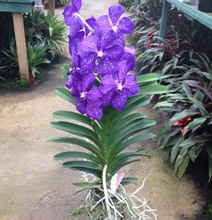What Are Orchids?
The orchid family is one of the largest groups of flowering plants on the planet. They can be found on every continent except Antarctica and in almost every conceivable habitat. With around 30,000 species growing in the wild and well over 120,000 man-made hybrids there is no shortage of choice in the orchid world!
The highest numbers of orchids grow in the rainforests, loving the humidity and shade provided by these environments. Not all orchids like hot conditions, though and many need cooler climates, as where they grow is at high altitudes in the mountains where the temperatures can drop very low at night.
As forest dwelling plants, many orchids grow as ‘epiphytes’, which means that they grow on the trees, clinging on with thick aerial roots and storing water in either fleshy leaves or thickened stems called ‘pseudobulbs’. There are also many orchids that grow in the ground, including our own native British species and these are known as ‘terrestrials’. Some orchids even grow on rocks and these are called ‘lithophytes’.
The orchid family is certainly the most diverse group of plants with so many various shapes, sizes, colours and patterns of their stunning and often extraordinary blooms. Whatever your taste in flowers, there is certainly something for everyone in the orchid kingdom.
Structure of a 'Sympodial Orchid'
 Sympodial orchids often have swollen stems called pseudobulbs which store water and food, giving the plant energy to continue to grow and flower.
Sympodial orchids often have swollen stems called pseudobulbs which store water and food, giving the plant energy to continue to grow and flower.
These bulbous orchids grow new pseudobulbs each year and it is those newest pseudobulbs that produce the next season's flowers. The older pseudobulbs never tend to flower again but they remain on the plant for many years giving it the support it needs to make more growth and flowers in the future. The pseudobulbs are excellent food storage organs which help the plants to get through drier periods in the year without dehydrating. If the pseudobulbs start to shrivel then this is a sign that the plant is too dry and it needs to draw on its reserves. Alternatively, if the roots rot through being too wet, this can also cause the pseudobulbs to shrivel as they are not able to take up any water. Pseudobulbs come in many different shapes and sizes, they can be round and fat or tall and slender, with everything in between.
Structure of a 'Monopodial Orchid'
 Monopodial orchids like phalaenopsis or vandas tend to grow with a central stem and fleshy leaves from either side. They also have plenty of aerial roots to help take up moisture as they have no pseudobulbs in which to store the water like the sympodial orchids do. These orchids tend to grow in habitats which are always moist, all through the year, so they don’t need to keep a large store of water in bulbs. If these plants get too dry or the roots rot, the leaves will start to shrivel and they dehydrate.
Monopodial orchids like phalaenopsis or vandas tend to grow with a central stem and fleshy leaves from either side. They also have plenty of aerial roots to help take up moisture as they have no pseudobulbs in which to store the water like the sympodial orchids do. These orchids tend to grow in habitats which are always moist, all through the year, so they don’t need to keep a large store of water in bulbs. If these plants get too dry or the roots rot, the leaves will start to shrivel and they dehydrate.
Non-bulbous orchids can often flower at any time of year as they don't always need to make new growth before they can flower again. Phalaenopsis are a good example of this.
